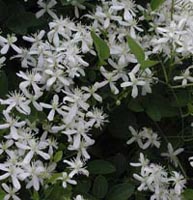Resource Library
Plant of the Week: Virgin's Bower (Sweet Autumn Clematis)
The University of Arkansas System Division of Agriculture does not promote, support or recommend plants featured in "Plant of the Week." Please consult your local Extension office for plants suitable for your region.
Plant of the Week
Virgin's Bower, Sweet Autumn Clematis
Latin: Clematis terniflora

Fall is a wonderful season in the garden, partly because we are relieved and a bit surprised anything has survived the overbearing heat of summer. Mostly it is a season of reds and oranges from the changing foliage, with an occasional goldenrod or aster sprinkled about to add contrast to the autumnal scene. But each September when virgin's bower blooms, I'm always startled by the purity of its white blossoms after the travails of a difficult summer.
Virgin's bower or sweet autumn clematis, Clematis terniflora, is a Japanese vine found scattered here and there in Arkansas along roadways or in gardens where it provides late season color. Our wild equivalent, Clematis virginiana -- also called virgin's bower -- is similar but with serrate, deciduous leaves, smaller flowers and a distinctively different seed head.
Virgin's bower belongs to the Ranunculus family and is, or so it seems to me, learning to be a vine. It has compound, three-parted, entire, gloss, dark green leaves on slender stems. Climbing is by a combination of sprawling and twisting the petioles of the leaves around nearby supports.
In late summer and fall plants produce masses of inch-wide, 4-sepaled blossoms with a number of slender stamens nested in the center of each flower. The fragrant flowers provide a hint of jasmine and are produced in units of three, giving rise to the species name. When in full bloom, the entire plant will be cloaked in a mantle of white. A bower is a garden shelter made from twining vines.
As the flowers fade, they are replaced by a cluster of solitary seeds, each bearing a long fuzzy tail that adds another aspect of beauty to the plant. These seed head clusters are the size of a golf ball.
Virgin's bower masquerades under at least four Latin names with C. paniculata being the most commonly used for the introduced species. Dr. Ed Smith, in his taxonomic atlas of Arkansas plants, uses the name C. terniflora, and shows it growing wild throughout the state.
Though this is an introduced plant and is occasionally seen sprawling on the top of a barbed wire fence, it lacks the competitive spirit of a Japanese honeysuckle or a kudzu. But in the garden, it needs some tending or it can overrun its neighbors. Because it is fall flowering, it can be cut back hard each spring and will bloom in the fall.
It grows best in reasonably good, bottomland soils where the roots are allowed to intermingle with other plants, but the top is in the sun. It can be trained to a trellis or allowed to sprawl on a fence, wall or shrub. A friend told me her virgin's bower reseeded freely in her garden, but I've watched a wild stand in Fayetteville for 30 years and see no sign of it spreading by seed. Probably it needs bare ground if it is going to spread this way.
As an experiment, I plan to plant virgin's bower under the skirt of my forsythia bush. If this works, and I see no reason it won't, the yellow forsythia blooms should give good display in the spring and then have a nice crop of white blooms come fall. This kind of horticultural double-cropping will allow me to maximize my display in the few sunny areas in my garden.
By: Gerald Klingaman, retired
Extension Horticulturist - Ornamentals
Extension News - September 30, 2005
The University of Arkansas System Division of Agriculture does not maintain lists of retail outlets where these plants can be purchased. Please check your local nursery or other retail outlets to ask about the availability of these plants for your growing area.